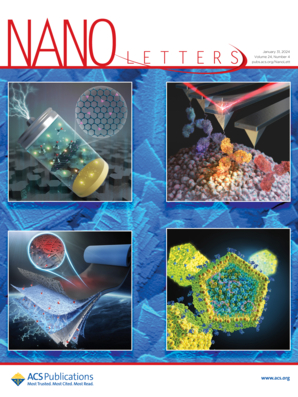单片集成的 TexSe1-x 短波红外线光电二极管阵列
IF 9.6
1区 材料科学
Q1 CHEMISTRY, MULTIDISCIPLINARY
引用次数: 0
摘要
TexSe1-x 短波红外(SWIR)光电探测器有望与读出集成电路(ROIC)实现单片集成,成为传统昂贵的 SWIR 光电探测器的潜在替代品。然而,高暗电流密度和探测性能不足等挑战阻碍了其在大规模单片集成中的应用。在此,我们开发了一种 ZnO/TexSe1-x 异质结光电二极管,并通过插入精心挑选的 0.3 纳米非晶 TeO2 界面层,协同解决了界面元素扩散和悬空键问题。优化后的器件在 -10 mV 时的暗电流密度降低到 -3.5 × 10-5 A cm-2,响应范围从 300 纳米到 1700 纳米,室温检测率超过 2.03 × 1011 Jones,3 dB 带宽达到 173 kHz。此外,我们还首次在 ROIC(64 × 64 像素)上单片集成了 TexSe1-x 光电二极管,是所有基于 TexSe1-x 的探测器中规模最大的阵列。最后,我们展示了其在透射成像和物质识别方面的应用。本文章由计算机程序翻译,如有差异,请以英文原文为准。

TexSe1–x Shortwave Infrared Photodiode Arrays with Monolithic Integration
TexSe1–x shortwave infrared (SWIR) photodetectors show promise for monolithic integration with readout integrated circuits (ROIC), making it a potential alternative to conventional expensive SWIR photodetectors. However, challenges such as a high dark current density and insufficient detection performance hinder their application in large-scale monolithic integration. Herein, we develop a ZnO/TexSe1–x heterojunction photodiode and synergistically address the interfacial elemental diffusion and dangling bonds via inserting a well-selected 0.3 nm amorphous TeO2 interfacial layer. The optimized device achieves a reduced dark current density of −3.5 × 10–5 A cm–2 at −10 mV, a broad response from 300 to 1700 nm, a room-temperature detectivity exceeding 2.03 × 1011 Jones, and a 3 dB bandwidth of 173 kHz. Furthermore, for the first time, we monolithically integrate the TexSe1–x photodiodes on ROIC (64 × 64 pixels) with the largest-scale array among all TexSe1–x-based detectors. Finally, we demonstrate its applications in transmission imaging and substance identification.
求助全文
通过发布文献求助,成功后即可免费获取论文全文。
去求助
来源期刊

Nano Letters
工程技术-材料科学:综合
CiteScore
16.80
自引率
2.80%
发文量
1182
审稿时长
1.4 months
期刊介绍:
Nano Letters serves as a dynamic platform for promptly disseminating original results in fundamental, applied, and emerging research across all facets of nanoscience and nanotechnology. A pivotal criterion for inclusion within Nano Letters is the convergence of at least two different areas or disciplines, ensuring a rich interdisciplinary scope. The journal is dedicated to fostering exploration in diverse areas, including:
- Experimental and theoretical findings on physical, chemical, and biological phenomena at the nanoscale
- Synthesis, characterization, and processing of organic, inorganic, polymer, and hybrid nanomaterials through physical, chemical, and biological methodologies
- Modeling and simulation of synthetic, assembly, and interaction processes
- Realization of integrated nanostructures and nano-engineered devices exhibiting advanced performance
- Applications of nanoscale materials in living and environmental systems
Nano Letters is committed to advancing and showcasing groundbreaking research that intersects various domains, fostering innovation and collaboration in the ever-evolving field of nanoscience and nanotechnology.
 求助内容:
求助内容: 应助结果提醒方式:
应助结果提醒方式:


